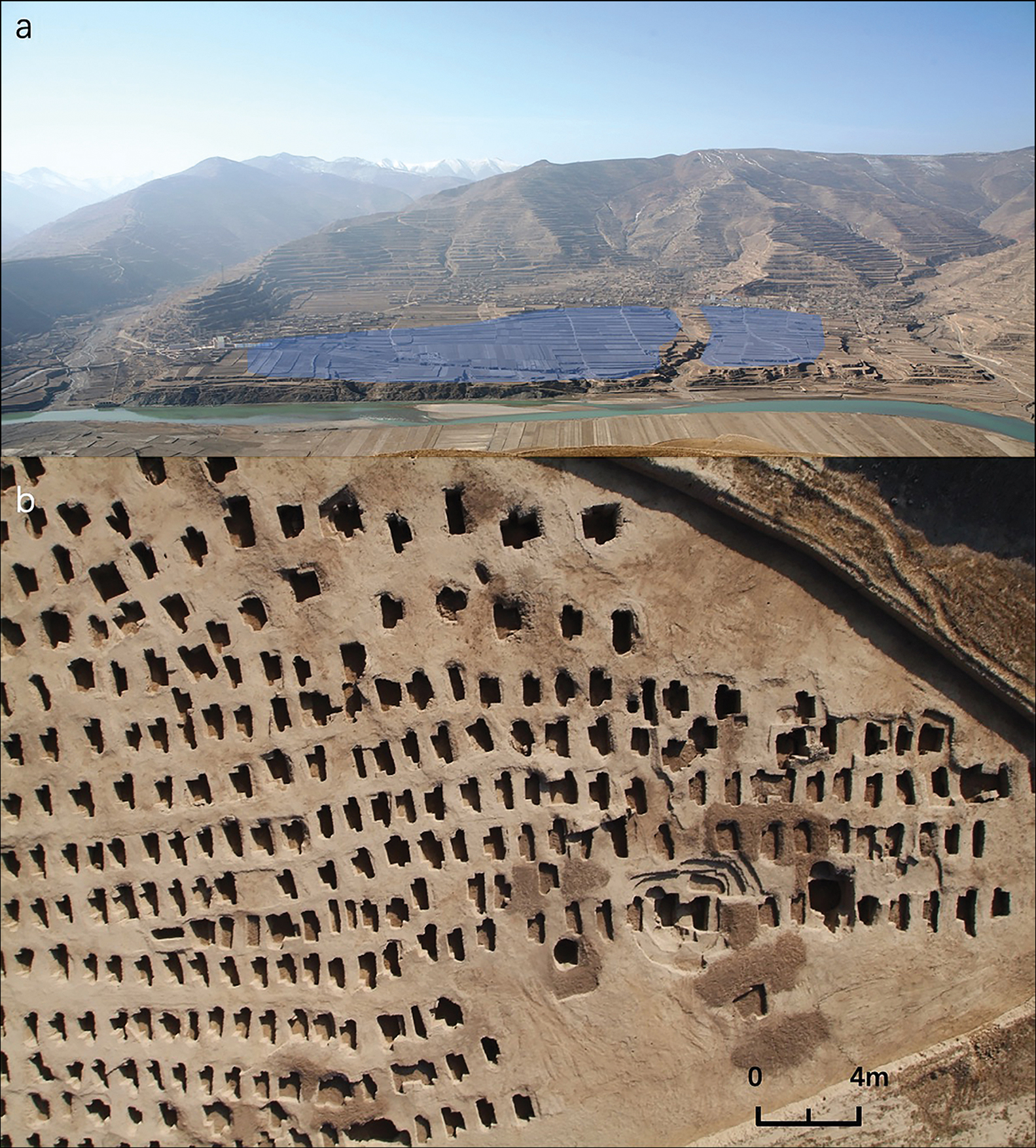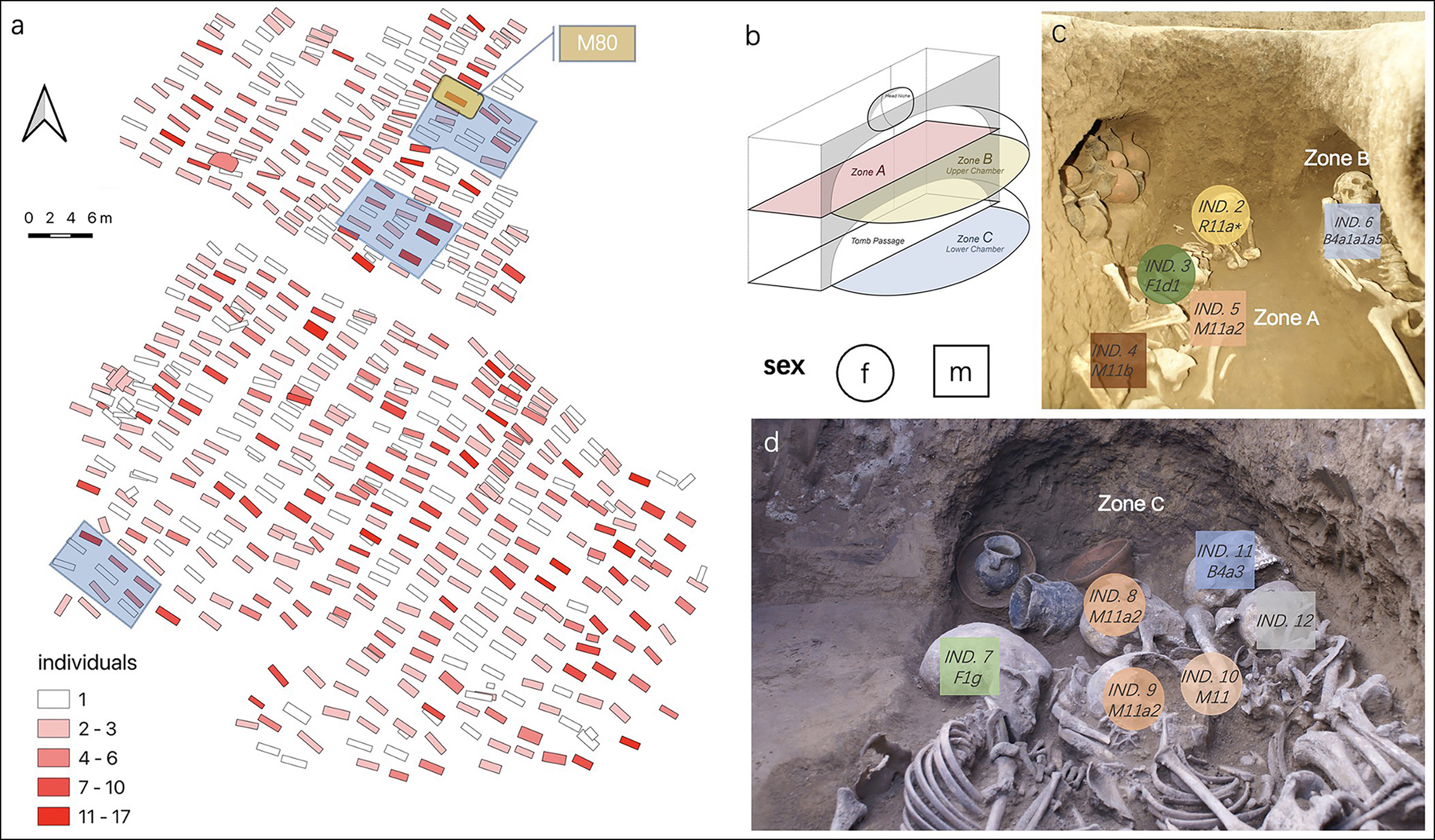Introduction
North-west China played an important role in trans-Eurasian cultural diffusion and population migration during the mid second millennium BC (Jaffe & Flad Reference Jaffe, Flad, Boivin and Frachetti2018) (Figure 1). Wheat and barley spread along the Hexi Corridor and regional metallurgical cultures were transformed. Little research, however, has been carried out on site-level social organisation and different political/economic strategies, and the mechanisms underlying cultural development and interactions across and beyond this vast region remain unclear.

Figure 1. Map showing north-west China and the location of the Mogou site (map by Xiaoying Ren).
Mogou (磨沟) is a Bronze Age cemetery situated in Lintan County, southern Gansu, along the terraces that line the Tao River (Figure 1). Covering over 30ha, Mogou is the largest and best-preserved Qijia Culture (1750–1400 BC) cemetery found to date (Qian et al. Reference Qian, Zhu, Mao and Xie2010) (Figure 2a). From 2008 to 2012, Mogou was among key excavations conducted by the Gansu Provincial Institute of Cultural Relics and Archaeology (GPICRA) and the School of Cultural Heritage at Northwest University. Over 1700 burials were uncovered, containing more than 6000 individuals. Situated on the eastern perimeter of the Eurasian Steppe, apart from local and Central Plains influences, a handful of the tombs also contained Andronovo-style gold accessories, highlighting Mogou's integration within a wider exchange network.

Figure 2. a) Panoramic view of the Mogou site (blue area) and the Tao River; b) east section of Mogou cemetery (photographs by Ruilin Mao).
Mogou society and the Mogou Multidisciplinary Investigation Project
Radiocarbon dating indicates that Mogou was occupied around 1750–1100 BC (Mao et al. Reference Mao, Qiang, Xie, Zhu and Zhou2009; Xie et al. Reference Xie2009). Material culture remains can be assigned almost exclusively to the Qijia Culture, alongside more than 100 Siwa Culture burials. Tombs were arranged in rows and rarely intersected, suggesting an intentional cemetery layout (Figure 2b). The cemetery featured two burial types—tombs with a side chamber (Figure 3a–b) and shaft graves (Figure 3c)—with no clear spatial patterning for either. Most Mogou graves were multiple burials containing anywhere between two and upwards of 20 individuals of either sex, and including all ages. Graves were often left partially unfilled following the first burial; covered with large stones or a wooden board, they were reopened whenever renewed interment was necessary.

Figure 3. Chamber (a) and path (b) of side chamber grave M230, which contained three adults and one child; c) shaft grave M216, which contained two adults (photographs by Ruilin Mao).
Mogou is therefore a significant site that can offer insights into burial practices, social organisation and kinship structure in second-millennium BC north-west China. Work over the last decade has shown that the combination of ancient DNA, strontium isotope analysis and radiocarbon dating can provide a local perspective, shedding light on inheritance rules, marriage practices and questions such as whether social status was related to a specific paternal/maternal lineage or a specific genetic structure, leading to a composite window onto socioeconomic processes and human behaviour (Mittnik et al. Reference Mittnik2019; Racimo et al. Reference Racimo2020). The Mogou Multidisciplinary Investigation Project, a collaboration between the Institute of Archaeological Science at Fudan University and GPICRA, aims to follow this lead and use these methods to analyse possible kinship ties, alongside the political and economic structures of the Mogou population. We are currently working on two key questions: how does utilisation of individual burial spaces/burial groups connect across the cemetery overall, and how does kinship influence political and economic strategy at Mogou?
We conducted a systematic survey of the archaeological materials and selected three areas within the cemetery for analysis. Our sample collection includes joint burials and individual burials containing different styles of artefacts, tombs with and without grave goods, and two different forms of Qijia and Siwa burial. The project will highlight the possibility of applying a multidisciplinary approach to Chinese archaeology from an anthropological perspective.
Preliminary findings
We focus here on M80, a Qijia Culture tomb with double niche-chambers (Figure 4b). Given the quantity of accumulated human remains and rich grave goods, it was presumably in use for a considerable period. Twelve individuals were interred within M80, falling into four spatial groupings. The first of these is represented by a single surviving skull (individual 1) placed at the entrance of the tomb passage. The second consists of individuals 2–5, buried deep in the centre of the tomb passage (Zone A). The third group, located in the upper side chamber (Zone B), contains individual 6. Finally, the fourth group is represented by the lower side chamber (Zone C) and features individuals 7–12 (Table 1). Radiocarbon dating of individuals 5 and 8 provided dates of 3456–3364 cal BP and 3569–3411 cal BP (both at 95.4% confidence), confirming the Qijia periodisation.

Figure 4. a) Plan of the Mogou cemetery (excavated in 2008 and 2009) and the three sample areas; b) schematic diagram of spatial structure of M80; c) middle of the tomb passage (Zone A) and upper chamber (Zone B) of M80; d) lower chamber (Zone C) of M80 (figure by Xiaoying Ren and Yao Yu).
Table 1. Sequencing results for individuals from burial M80. Dates calibrated using the IntCal20 curve (Reimer et al. Reference Reimer2020) in OxCal v4.4.2 (Bronk Ramsey Reference Bronk and Ramsey2009) and are presented in calibrated calendar years BP.

1 Mt_Depth refers to the ratio of the aligned mtDNA bases to the total number of reference mtDNA bases.
2 We used HaploGrep 2 (Weissensteiner et al. Reference Weissensteiner2016) to assign the mtDNA haplogroups.
3 Y chromosome haplogroups were examined by aligning a set of positions in the ISOGG (International Society of Genetic Genealogy: http://isogg.org/).
DNA analysis of individuals 1 and 6 failed due to poor sample quality, although 10 valid mitochondrial genome sequences were obtained. Eight different mtDNA haplogroups were identified for the remaining 10 individuals, indicating high maternal diversity among tomb occupants (Table 1). M80 is characterised predominantly by the presence of the most typical eastern Eurasian mtDNA haplogroups (B4, R9 and M11). The Y-chromosome haplogroup of individuals 4, 5 and 7 was identified as O-F8 (a sub-haplogroup of O-F5, both downstream markers of Oα-M117). Oα-M117, thought to derive from Yellow River Basin Neolithic farmers, represents a major founder paternal lineage of present-day Han Chinese, with over 16 per cent exhibiting the Oα haplogroup (Yan et al. Reference Yan2014).
In terms of the spatial distribution of mtDNA haplogroups, female individuals 8 and 9, who share haplogroup M11a2, were buried together in the lower chamber next to female individual 10, who possibly also shares M11a2. Male infant individual 5, buried in the tomb passage, shared haplogroups with individuals 8 and 9 (Figure 4c–d), with identical mitochondrial mutation loci indicating a probable maternal relation. The similarity in mtDNA haplogroup, combined with the spatial distribution of grave goods in the tomb passage and chamber, supports the supposition that the tomb passage was probably considered a legitimate burial space during the final period of the tomb's use. In addition, a type consistent with the mtDNA haplogroup and mutation loci of individual 11 was found in adjacent burial M90, indicating a maternal relationship between individuals in these two tombs. Y- chromosome and mtDNA haplotypes contain only information regarding the paternal or maternal lineage. The results suggest the possibility of paternal/maternal ties between individuals in these burials that impacted the arrangement of space within them and the location chosen for interment. Our initial results will be extended by complex kinship analysis at the genome-wide level.
Future prospects
The Mogou Multidisciplinary Investigation Project will enhance our ability to test interpretative models on rules of inheritance and mobility at Mogou and ultimately improve our understanding of Bronze Age political and economic strategies in north-west China. Our explicit spatiotemporal and microregional framework will help us recognise that ancient individuals do not always fall cleanly within culturally or genetically defined groupings. Furthermore, we believe that the project's integrated approach will help train the next generation of interdisciplinary researchers and establish a demonstrably sustainable model of collaboration between archaeologists and geneticists.
Funding statement
The work was funded by Major Project of National Social Science Foundation of China (18ZDA225 and 20&ZD212), National Key R&D Program of China (2020YFC1521607), the National Natural Science Foundation of China (32070576) and the Shanghai Planning Office of Philosophy and Social Science (2020BLS002).








